Today, when you search for ‘best project management platforms’ on Google at least 5 of the top 10 resources that appear, mention ClickUp. It’s hard to believe that this SaaS company was only founded some five years back. Such speedy growth is only possible if you’ve done almost everything right – including content marketing – and that’s not easy. For a brand to be noticed, perceived, and appreciated by the target market, just having a solid product isn’t enough. Their content marketing has to hit the nail on the head as well, for people to see its true value. In this content marketing case study, we try to dissect ClickUp’s content marketing strategy to understand how they made sure their brand is seen and recognized in so little time.
- Background
- A content marketing case study on ClickUp’s content strategy
- Product-led growth and product-led content marketing all the way
- Eyes on the right buyer personas
- User insights to help deliver better content
- A plethora of resources and videos for ClickUp users
- Turning ClickUp alternatives into a competitive advantage
- Engaging users with value and humor on YouTube
- Keeping up with social media trends
- B2C marketing tactics for a B2B company
- What we learned from the ClickUp content marketing strategy

Background
ClickUp is a project management software founded by Alex Yurkowski and Zeb Evans in 2017. The company is headquartered in San Diego, California. The idea for the product was born when the founders were working on a different project. They found that everyone on their team was tired of toggling between multiple tools and it was costing them in terms of productivity. And this is true for most teams. In the 2019 State of the Services Economy Report by Mavenlink respondents from 73% of companies agreed that they spend an average of one hour every day navigating between different apps.
ClickUp started as an internal project management tool for minimizing this loss and bringing all their activities to a single place. The platform offers users multiple productivity tools combined into one comprehensive platform. It includes goal-tracking, whiteboards, dashboards, task management, checklists, and more. They soon realized that many other teams have a similar challenge and this could be their answer to it.
As of 2021, Clickup acquired over 4 million users across its paid and free plans, including big names like McDonald’s, Zynga and others.
Despite immense competition in the industry they were venturing into, ClickUp managed to make a mark for themselves among already established platforms. This content marketing case study takes a deeper look into how content marketing fired up ClickUp’s growth engine, what they’ve been doing differently and what we can take away from ClickUp’s content marketing strategy.
TL;DR – Here’s a quick video highlighting the key insights of this content marketing case study on ClickUp
A content marketing case study on ClickUp’s content strategy
ClickUp’s approach to content creation and marketing is not the mundane, traditional kind that you would expect a SaaS company to adopt. As a startup, you would usually expect them to be skeptical about experimenting. But the founders have been quick to realize that if you have to sell the product, the product has to be able to sell itself first. ClickUp Founder and CEO, Zeb Evans, has always stressed on the importance of finding a product-market fit. Zeb believes that when the right customers become aware of your product, start using it and tell others about it, that is where your growth starts.
You can spend dollars on advertising and PR, but for a small startup that’s running on VC funding, making such huge investments without perfecting the product first can have disastrous outcomes. What you need instead is a smart strategy and the right content marketing tools.
Product-led growth and product-led content marketing all the way
Zeb shares that he found the ‘natural’ product-market fit to be a more sustainable way of acquiring new users and building brand awareness, rather than doing it artificially with paid campaigns and Google ads. This reflects in ClickUp’s product-led content marketing strategy.
Product-led content marketing is where you weave your product into the narrative of your content effortlessly. It demonstrates how your product can be used to solve the audience’s problem, in turn helping the audience discover that you have the right tool for it.
So you are putting your product in front of the audience without pumping money into paid ads. You are delivering the value that they seek, but also discreetly promoting your product showing them its various use cases.
Take a look at the ClickUp blog content and you will know just what we are talking about. Every blog post on ClickUp is product-led content. They have a dedicated Product category on the blog which shares different articles, use cases, case studies, and more on their product.
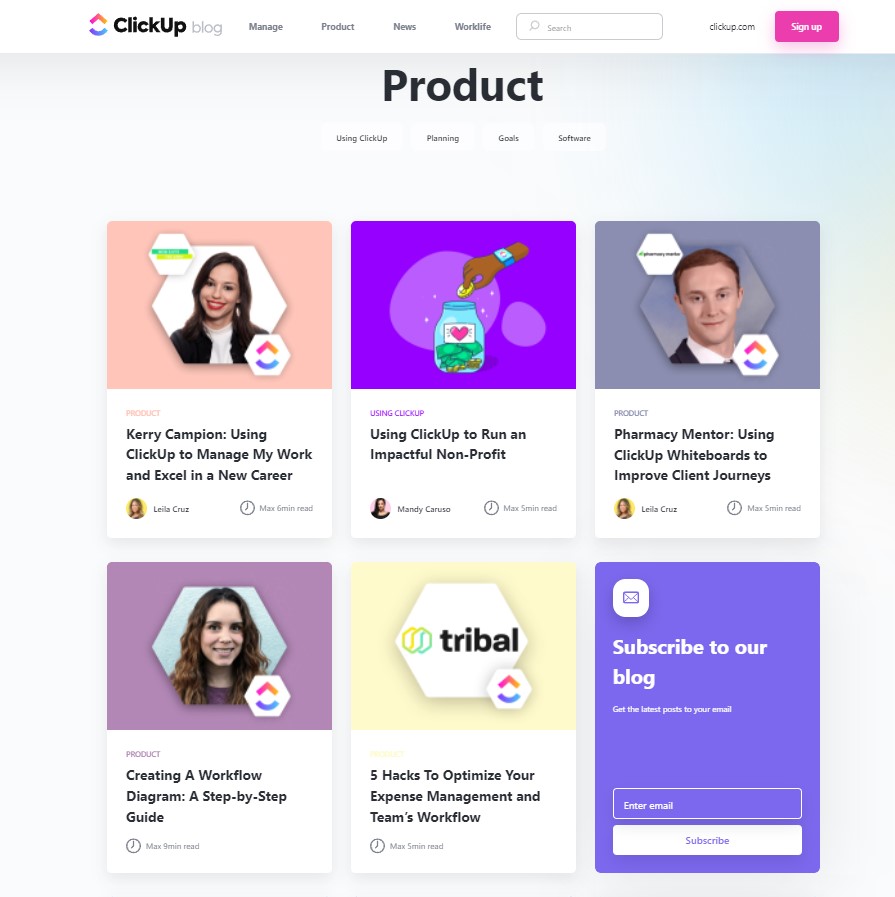
Under the Product category of their blog, almost every article tells you about how a client used ClickUp to manage their teams, workflows, and so on. There are also articles and guides on how to use the different features on ClickUp.
But apart from this category too, the ClickUp blog posts never fail to put their product at the helm of their content. For instance, here’s a post from the Marketing category on their blog, which discusses ‘How Development and Marketing Teams Can Work Together Better‘. The post starts by stating the facts and data, as all impactful content should.
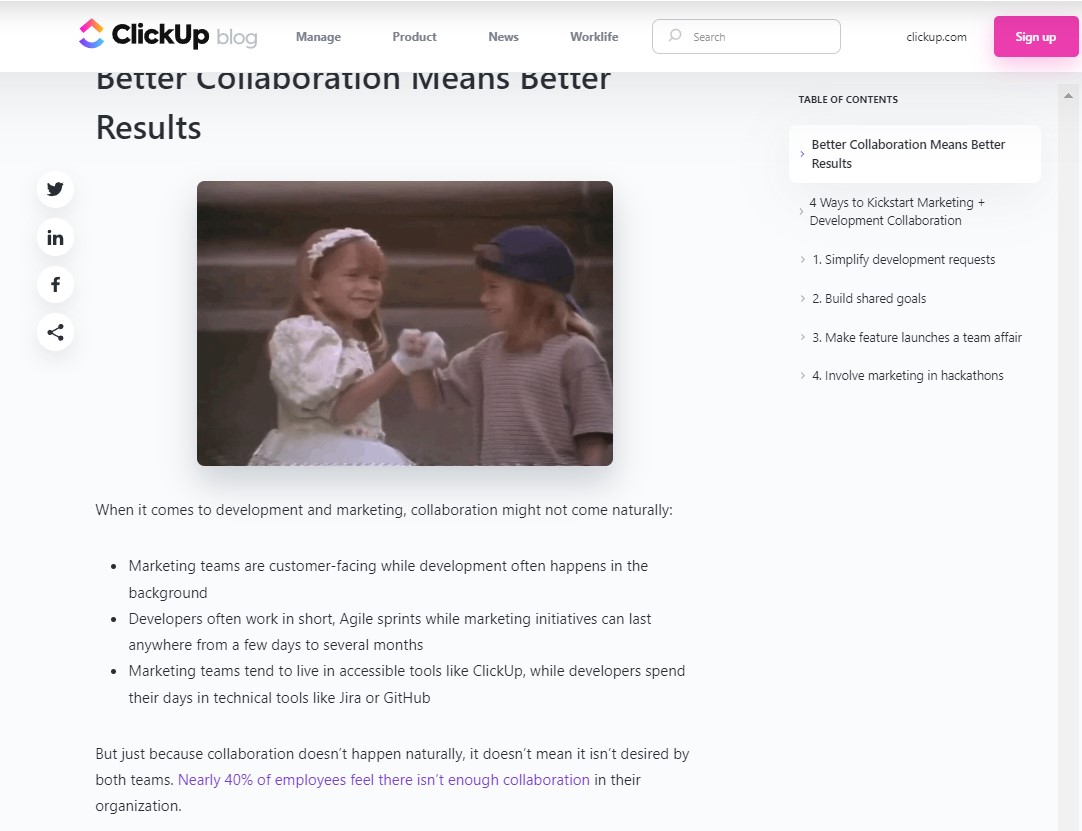
But as the audience gets drawn into the content and begins to see the value they’re getting from it, the author very tactfully introduces ClickUp as a solution in one of the examples.
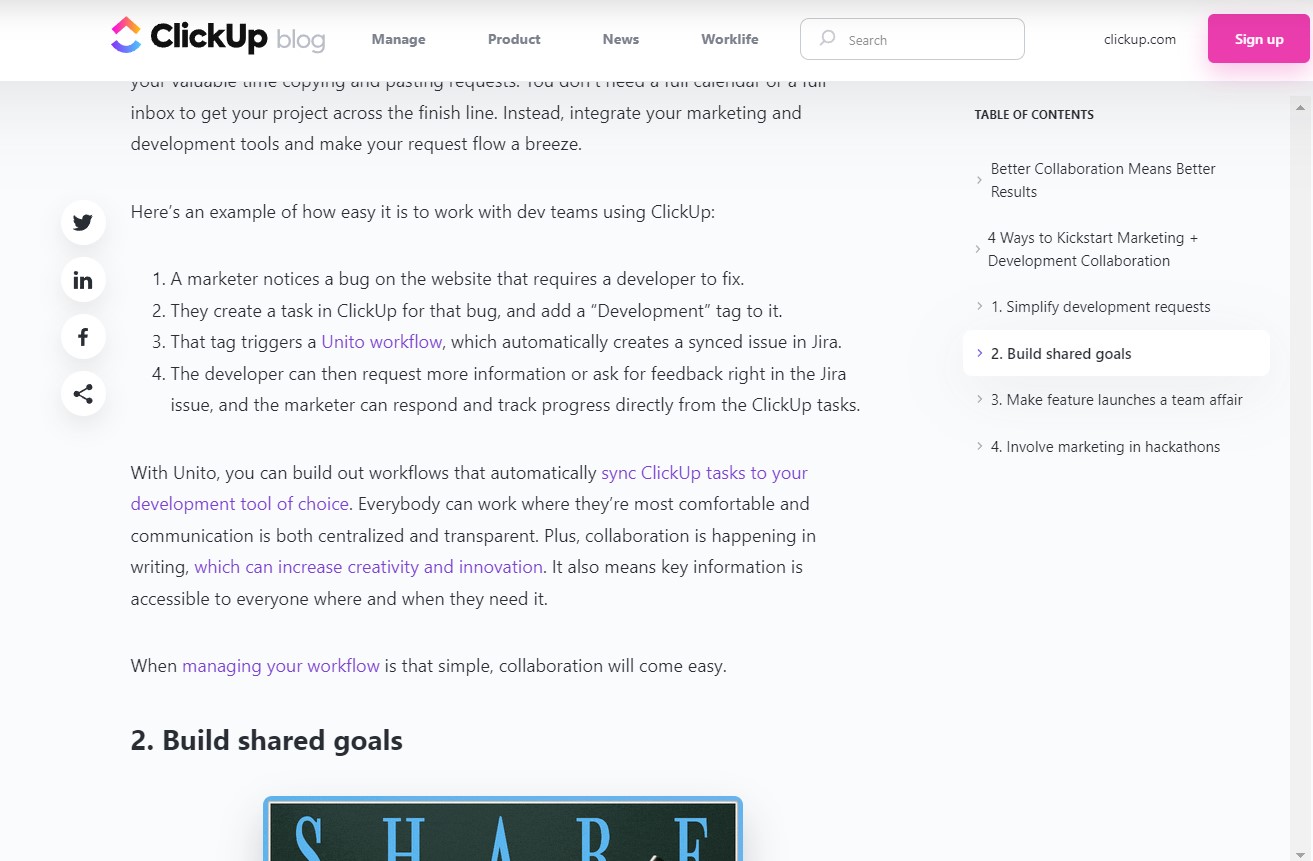
This is true for every article on their blog, even when it’s not a ClickUp case study or a feature introduction of their product. The content encourages readers to try out the product, maybe the freemium version, and what you get from here is product-qualified leads. Their content actually plays a huge role in user acquisition.
In fact, product-led content marketing is a winning customer acquisition strategy for most successful SaaS companies. In our Airtable content marketing case study, we’ve discussed how they weave their product into their articles to deliver more value to the reader. Our case study on the Notion content marketing strategy also reveals how Notion has also been using product-led content to win over new customers. Give it a read!
Eyes on the right buyer personas
By focusing on getting a natural product-market fit, ClickUp has been able to get their buyer personas, and thus their content’s audience personas, right from the very beginning. They’ve realized that it is usually startups, SMBs, and agencies that struggle most with the same productivity issues they had and these are the teams/organizations that have found the best use for their product.
This insight helps them with content creation targeted at the right audience, helping them draw the attention of more potential customers. On the ClickUp blog, you will find several posts on topics like Agency Project Management, Agency Efficiency, Agency Productivity, Best CRM for Startups, Best Tools for Startups, Startups vs Corporates, and so on.
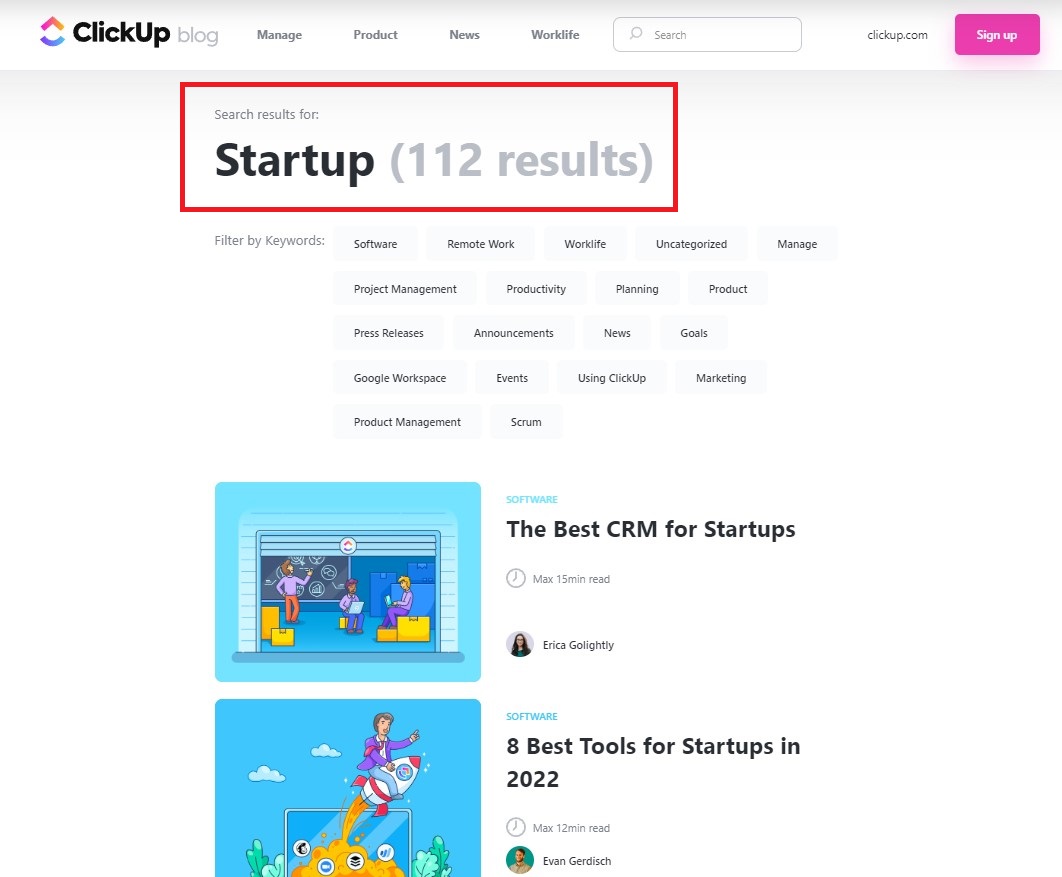
By identifying who they cater to, or who can make the most of their product, they are able to leverage the right keywords to meet the ideal users’ search intent. As a result, more and more people from their target market are able to find their content, discover their product, and convert into paying customers.
For driving organic traffic to your blog, SEO is the very first thing you need in an effective content process, apart from great content, of course. And when your buyer personas are clear to you, optimizing the content for search becomes a lot easier.
Bonus tip: Mastering SEO to this extent is going to be hard unless you have a powerful SEO planning tool. Knowing which keywords to target, what topics to grab people’s attention with, what questions to answer, etc. needs deeper insights and competition research.
On Narrato, for instance, you can generate automatic SEO content briefs. You can type in your topic or search term for the planned content and within seconds an SEO content brief is created. This contains keyword suggestions, questions to include, competitor links, and other SEO parameters like word count, paragraph count, and more. During content creation, you also get dynamic updates on the number of times a keyword is used in the article/post. These SEO content briefs can also be a part of broader content briefs you share with your writers on the platform.
There is an AI topic generator on Narrato too, that can give you new topic ideas for your target keywords. So you’ll never run out of content ideas, to compete with existing content on the web.

User insights to help deliver better content
In their efforts to achieve product-market fit, as Zeb Evans mentions in this post – 3 Things I Learned Bootstrapping ClickUp to $20M ARR in the World’s Most Competitive Industry – they gathered user insights in huge amounts. They were always trying to understand what problems users were trying to solve with the product, where they had been successful, and where they felt the need for more. Apart from helping them make improvements to the product, these insights also gave them new ideas for content.
With actionable feedback from their organic users, they were able to identify audience pain points and create valuable content to address these challenges. The content not only helped users solve their problems, but also allowed ClickUp content marketers to position their product as a solution/alternative in new ways.
This takes product-led content marketing to another level.
A plethora of resources and videos for ClickUp users
Just like we observed in the Marketo content marketing case study, ClickUp’s content marketing strategy goes beyond just blog content. On the website, you will find a whole library of resources. From self-serve demos to tutorials to on-demand webinars, there is a range of content types for new users and potential customers to learn more about the product, even before getting onboard.
There is a dedicated ClickUp video library that shares video content to help users get started, customize their workspaces and learn more use cases of the platform. There is also a library of templates for different use cases and users such as Creative & Design teams, Engineering & Product teams, Marketing teams, and so on. These templates help users understand the working of the various tools faster and get started right away.
ClickUp has gone on to show, that content goes beyond just building brand awareness and capturing leads. It can also help with user retention and customer success by adding value at every stage, which is the primary focus of product-led growth.
Turning ClickUp alternatives into a competitive advantage
The ClickUp website is another forefront of their inspiring SaaS content marketing strategy. Apart from the smart and crisp copy on their website, you will also find a host of comparison pages on the site. These pages show you how ClickUp compares to its competitors like Asana, Trello, Notion, Monday.com, and others.
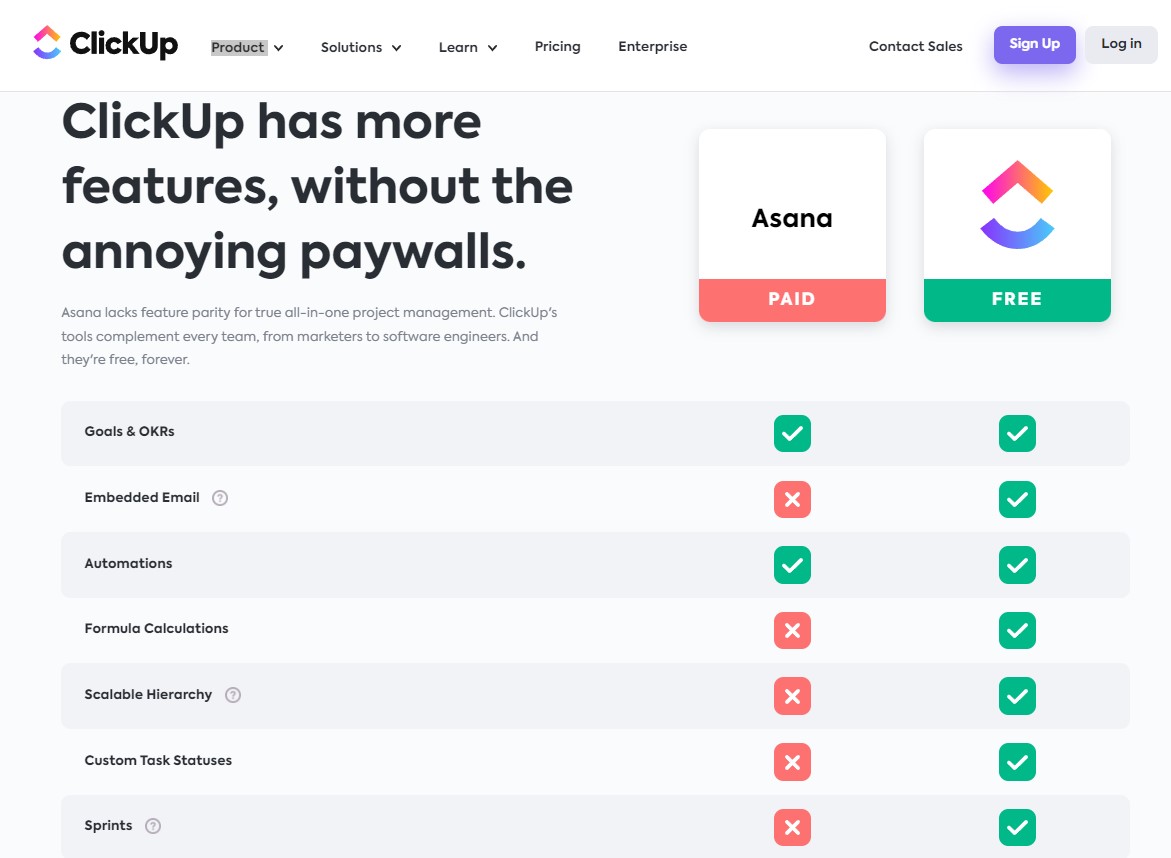
In a market with such cut-throat competition, it helps them demonstrate to their audience what they’re offering that others are not. Or what they’re offering at a much lower price.
From the SEO perspective too, these comparison pages help their website rank for keywords that their competitors are ranking for, such as ‘alternatives to Asana’ or ‘Trello alternatives’. This plays a huge role in getting organic traffic to their site and acquiring more users eventually by showing them the value of the product.
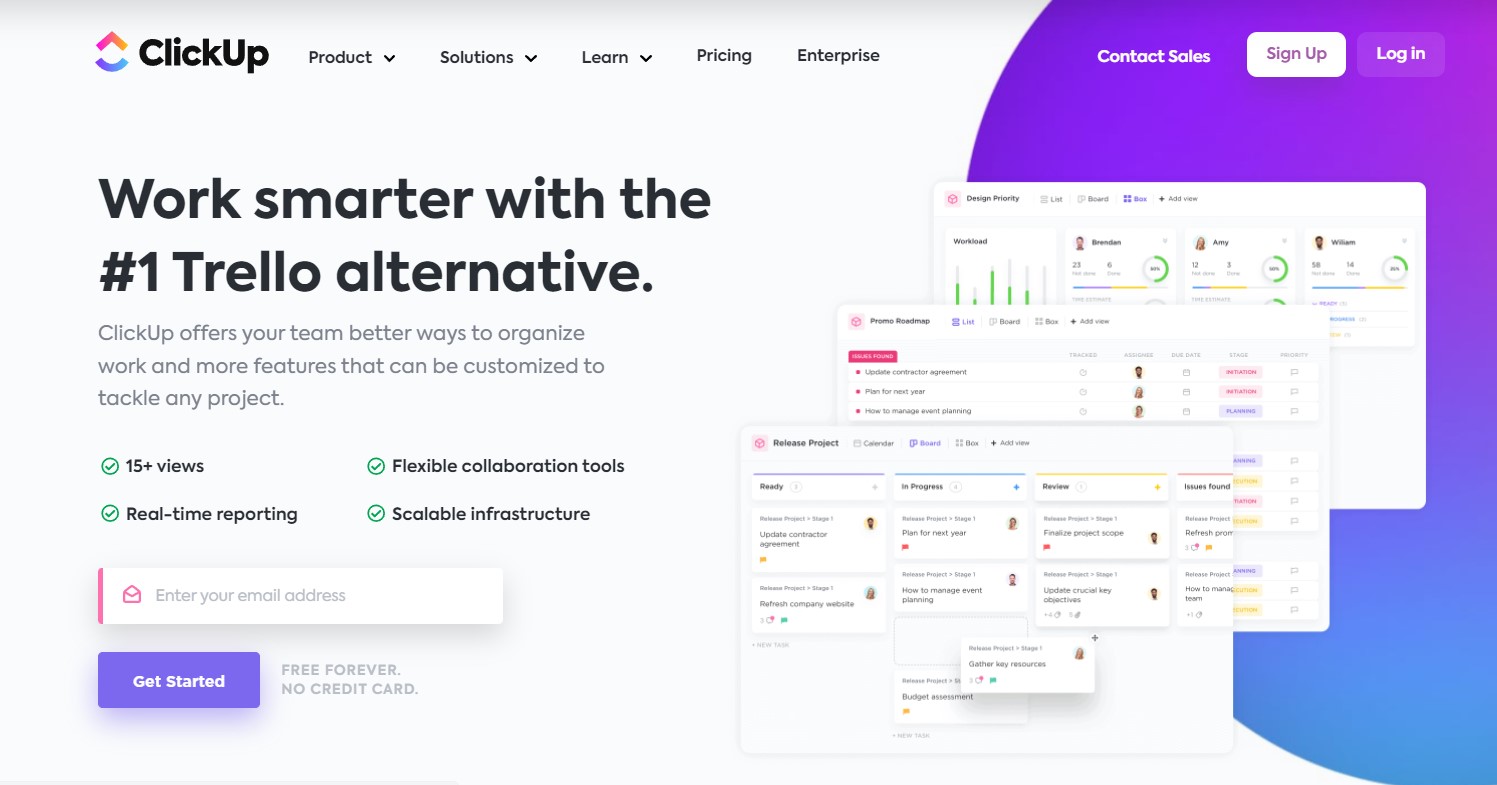
Engaging users with value and humor on YouTube
ClickUp’s content marketing game is just as strong on other platforms too. Take the ClickUp YouTube channel for example. You will be amazed by the range of content the channel offers. From all their webinars to product tutorials to case studies repurposed as podcasts, there is something for everyone in their target audience. This is something we also observed in our Hubspot content marketing case study. With audiences demanding more value in less time, YouTube seems to have become a primary channel for brands to build authority.
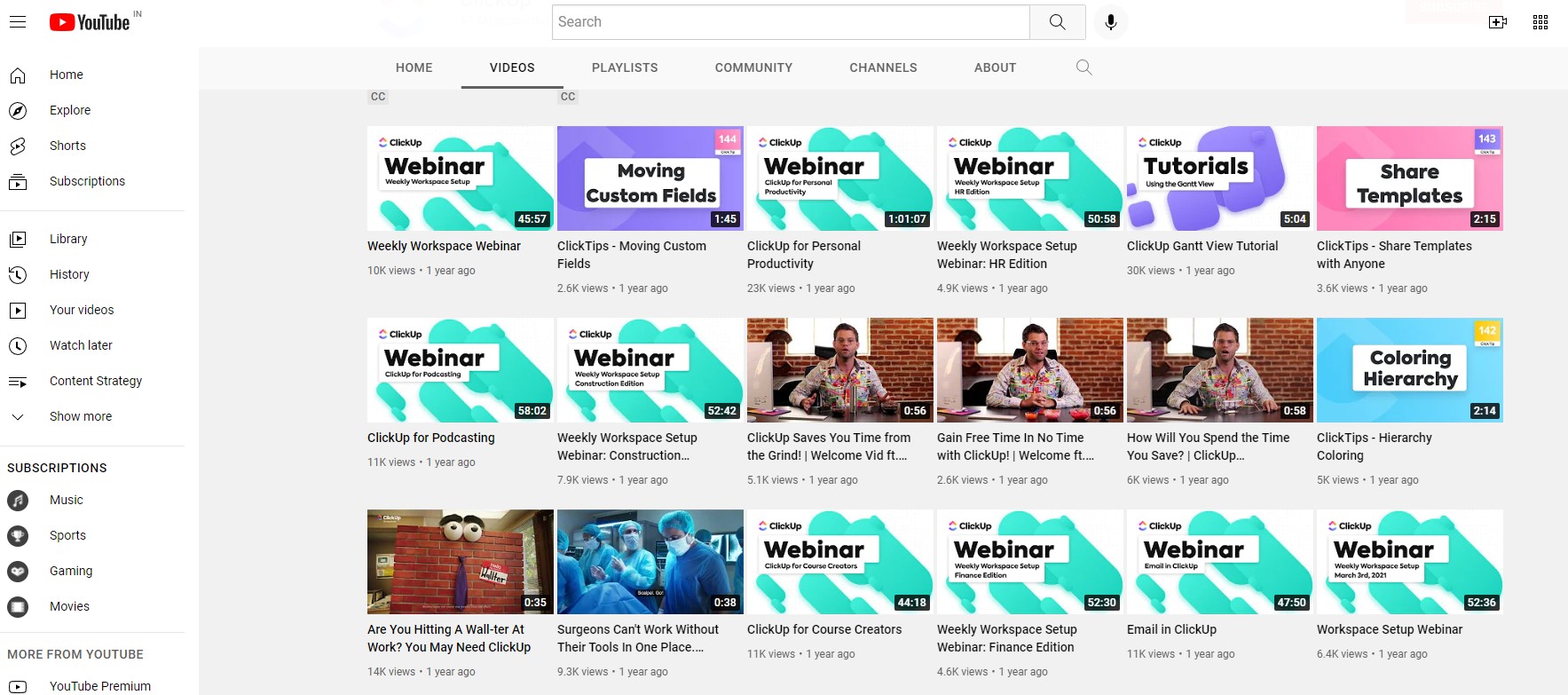
ClickUp also hasn’t compromised on building connections and engagement with their YouTube content though. The channel has some very humorous content and ads that are sure to connect with the audience and break the monotony of serious marketing content. Their ‘Returning to Work’ series is a classic example.
It is also not rare to see the Founder and CEO, Zeb Evans, himself addressing the audience in some of the videos. Having people see the faces behind a brand helps build trust and credibility, and they know it. This SproutSocial survey, for instance, found that 70% of consumers feel more connected to brands whose CEOs are active on social platforms.
Keeping up with social media trends
On social media too, ClickUp is putting its best foot forward. They have a presence on every major social platform and the content they publish is always relevant to these platforms and the audience on them. For instance, on the ClickUp LinkedIn channel, you will find lots of productivity tips, screen grabs of their various features, updates on events and webinars – all of which align with the primary reason why people go on LinkedIn – for professional growth.
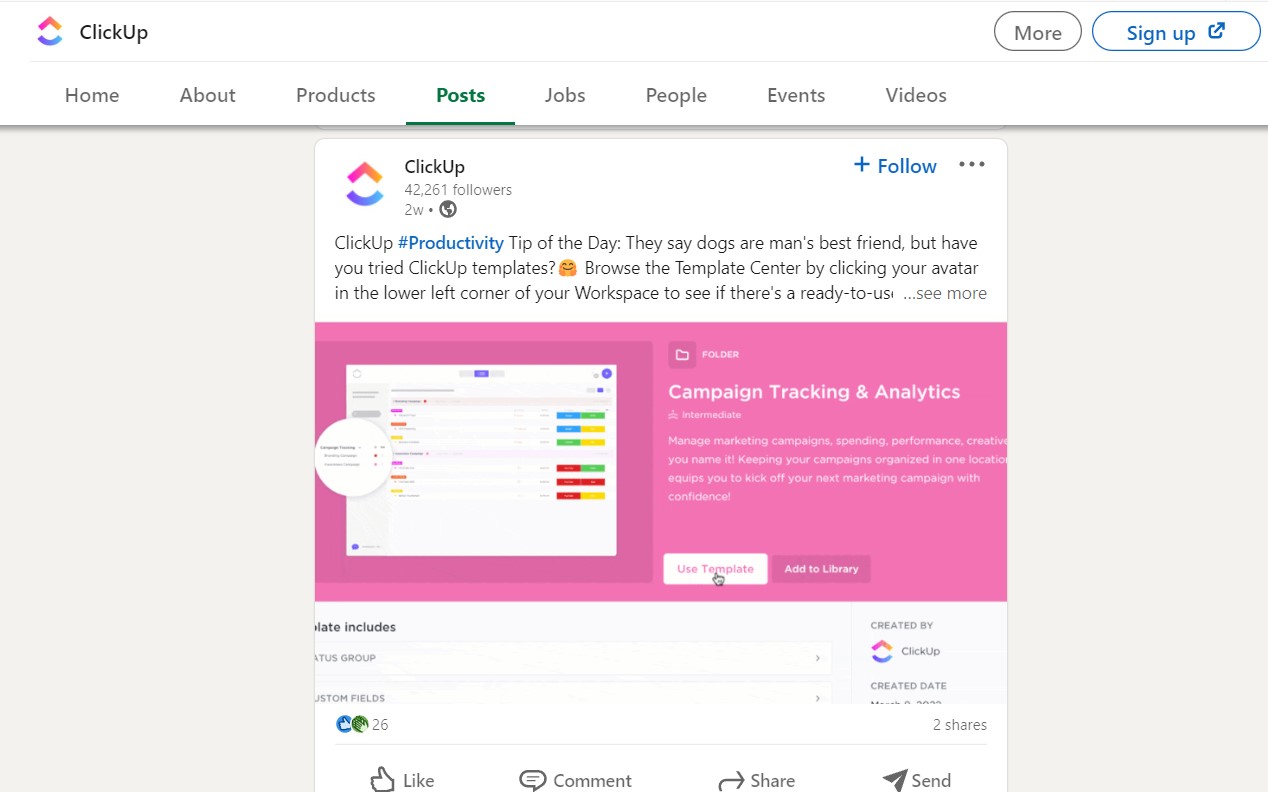
On Instagram, on the other hand, ClickUp shares their ads, behind-the-scenes from their office, work culture and employee appreciation posts. Basically, everything on their Instagram account is usually more casual and fun, to give people what they seek from this platform. Their social media handles make sure to stay on top of content marketing trends, for instance posting reels and videos on Instagram, which helps them build more connections on these platforms.
Here’s an example from their Instagram feed.
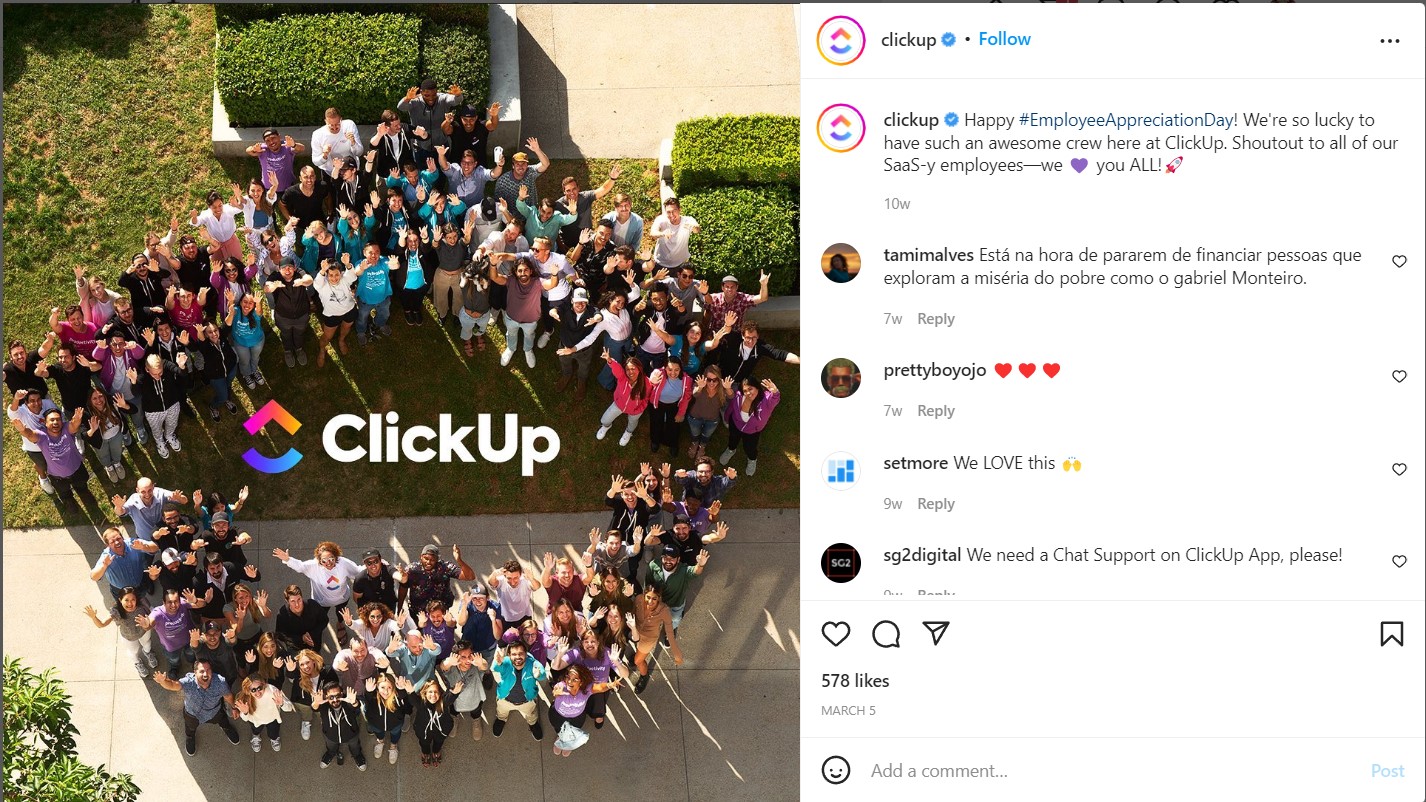
B2C marketing tactics for a B2B company
When it comes to product-led growth, it is important to remember that referrals and word-of-mouth play a huge role. ClickUp realized that the best advocates of their products would probably be individual users who love using the product and introduce it to their teams or organizations. This is why ClickUp broke the stereotype of B2B content marketing and did not just stick to the usual inbound tactics.
They also used B2C marketing tactics like putting up billboards and bus ads to catch the attention of individual users.

A ClickUp ad on the streets of New York (Source: ClickUp)
So, the SaaS content marketing strategy at ClickUp does not seem to adhere to the traditional funnel that most other SaaS startups would focus on. They have always believed in going wide, targeting anybody that could be a potential user, getting them to try the product, and building a community around it.
Of course, advertising at this scale is only possible once you have enough funds to spend on marketing. In an article for Fast Company, Zeb Evans mentions that they only started investing in paid campaigns for brand building when they had an influx of additional capital, to help the company scale.
The ad in the image above is from 2020, which is when ClickUp managed to raise $100 million in Series B. They could afford this only after relentlessly improving their product and scaling their business exponentially over the past three years. This is an important lesson to learn for all startups – investing huge money in ads only makes sense when you know your product has potential and you have been able to prove its worth so far.
What we learned from the ClickUp content marketing strategy
After our deep dive into ClickUp’s content marketing strategy, here are the key points we observed in this winning approach –
- Improving the product and letting the product sell itself – product-led growth
- A deep understanding of user personas and users’ pain points
- Not shying away from competition but using them to advantage
- Offering tons of self-serve and on-demand educational content for users to learn about the product
- Taking an omnichannel approach to content creation/ marketing and understanding the purpose of each channel
- Targeting individual users to get more product qualified leads
- Investing in paid marketing and sales only when you have enough funds to spare for these activities
For many SaaS startups, the ClickUp marketing strategy is an inspiration. It shows us that if you have a product to sell, the product should be your prime focus. When you’ve done all you can to better your product, gather feedback and improve it a little more, it doesn’t take much to convert audience interest. Your content will help you find the right audience, show them what your product does that others don’t, and give them a reason to sign up.
But the role of content doesn’t end there. From that point forward, you will need more content to retain users and upsell by showing them more ways to benefit from your product. In a content marketing strategy like ClickUp’s the product drives the content and the content supports the product – it is a mutually dependent relationship.
Looking for an alternative to ClickUp for content creation?
ClickUp is a powerful project management software in most aspects, but for content marketing teams, the requirements are very unique. From setting up content creation workflows to implementing them, there are very few platforms that help content marketers keep a tab on their projects. What they need are robust content marketing tools that are built specifically for content operations. Narrato is an alternative to ClickUp for content creation, collaboration, and workflow management, among other things, that offers everything a content team could need for effective content project management.




